[ad_1]
Somehow, I’ve spent nearly 40 hours playing Nightingale, but I’m still searching for the fun. I’ve seen glimpses of the game I feel we’ve been promised – the Victorian fantasy where friends glide through the air on umbrellas, fighting mythical beasts together in strange fae lands – but only ever glimpses. Mostly, I’ve been in dogged pursuit of an excitement that eludes me, hoping it’ll be around the next corner I turn, in the next gear tier I unlock. But every corner seems to just bring another corner, and so around and around I go, getting somewhere but never there.
It’s a shame because as a concept, and even in practice, there are things I love about Nightingale. The setting! A Victorian world of old-fashioned explorer garb and backpacks, of canvas and ironwork. And the fantasy world lurking just beside it, filled with unexplained phenomena and menacing faerie folk. It’s pulled almost one-to-one from the pages of Susanna Clarke’s brooding fairytale Jonathan Strange and Mr Norrell, which I adore – they’ve even cast Marc Warren from the television adaptation to reprise his role as a faerie, which he does with sinister brilliance again. In Nightingale, the doors to the faerie realm have been blown wide open, and humanity scattered throughout the immeasurable archipelago of rae realms. Now, humanity is trying to find a way home, hopping through portal after portal as it tries to get back the eponymous city of Nightingale.
It’s a refreshing set-up that’s perfect for a survival crafting game, because it can be broken into myriad small realms to adventure on. These self-contained realms can be procedurally generated and offer varying threats, treasure, resources, depending on whatever seed you generate them from – the seed in this case being cards, which are another of the game’s big ideas. These are craftable and collectable and open doorways depending on the cards you use. Match a desert or forest biome with a card representing a certain difficulty, and it will then appear. It’s a great idea that works brilliantly with the setting of Nightingale to make the game feel distinct.
Cards can also be used to alter the properties of a realm while you’re in it, which is really cool. There’s a machine you can use cards on to alter, say, gravity and jump strength, meaning you can bound around through the air; or you can increase the amount of treasure that you find; or you can dial up the amount of resources you harvest. They’ve all got their pros, they’ve all got their cons. Better yet, there’s a visual spectacle to doing this. You can visually alter the whole look of a realm, dramatically changing the weather conditions and the sky box itself, making a big blood red moon appear, for instance, or thinning the atmosphere so that space can be seen more clearly around you. It’s great.
I like the character creation, too, not only the caricatured styling of the faces, with their big features, but also the way you can populate a family tree with which to further differentiate yourself – sliding your likeness closer to your grandparents’, or your parents’ – and how there are backstory options to set your equipment and get you into the game. It all feels like the start of an absorbing RPG to me, though there’s currently no link to either your lineage or your backstory in the game world, which is a shame.
There’s also the semblance of a story when you do begin, led by the faerie Puck, voiced by Marc Warren, as mentioned above, who introduces you to the world and your first steps in it. It’s with those first few steps you’ll discover pink trees and orange bushes, and strange floating buildings, and bizarre creatures. And it’s in these moments, Nightingale feels new, feels magical, as you gawk at a strange land while building your first flimsy home there. It’s instinctive survival, and the survival-crafting genre at its most effective and persuasive. Sadly, though, that feeling doesn’t last.
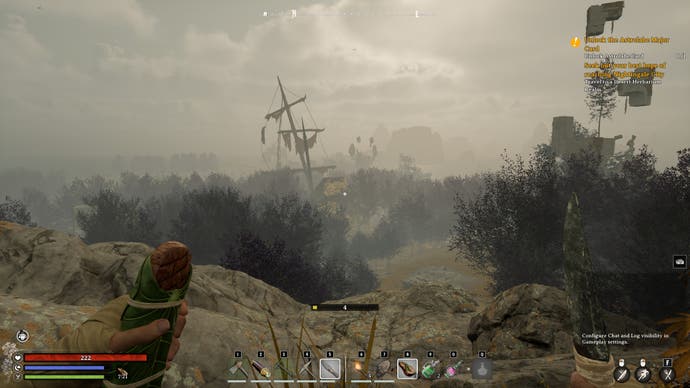
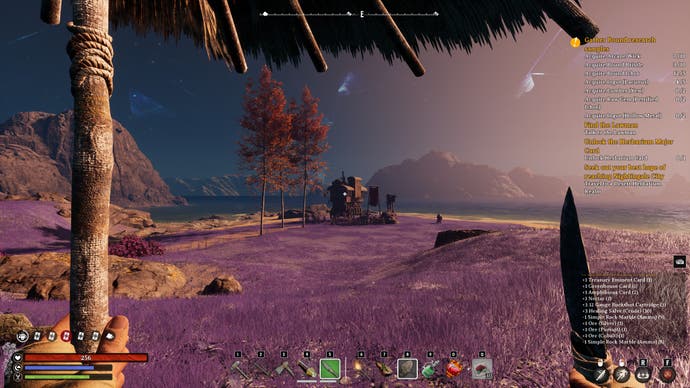

Nightingale is a survival crafting game, so you need to eat and sleep and craft everything you need. You’ll need to chop trees, gather sticks and stones, rip down bushes, skin animals, mine rocks, fish, and so on. And from those resources you’ll begin to build a home and the equipment you need to build a better home and better equipment with. It’s a loop that by now we know well, and there’s a lot of depth on show here. I really like the augmentation system whereby you build an object nearby a machine – like a kettle (I kid you not) – that then improves or expands what that machine can do. I like it because it means your home soon has all kinds of accoutrements scattered around it, like a real home, that also serve a purpose. It underpins a kind of strategy for placing machinery so that it enhances other nearby machinery, and there’s a pleasant mental puzzle here to enjoy. I only wish you could move machinery after you place it, because currently you can’t, and it’s annoying. My house is, increasingly, a mess.
What irks me about the survival crafting side of the game is the grind of it. Nightingale works on a Gear Score system, a bit like Destiny does, and the game will refuse you entry to certain dungeons – on your mainline quest – until you reach the Gear Score requirements for it. Partially, this makes sense, because enemies there will be more dangerous, but when you’re only a point or two away, it feels unnecessarily fussy. It also feels as though the game is forcing you to do things its way rather than yours, hemming in your perceived sense of freedom. This is added to by the way Nightingale handles crafting recipes. It doesn’t let you discover your own through experimentation, but requires you to unlock each individual recipe, either by earning rewards or by trading with specific Essence Trader NPCs.
The problem comes in how eager Nightingale is to impress this loop upon you early on, when you can’t do much, the enemies are boring, and everything feels like a slight variation of the same. Need a better Gear Score? You’d better imbue all of your existing equipment with Essence. But you’ll need to farm Essence from enemies first. Oh but here’s a recipe for a slightly better piece of equipment! You’ll need a new kind of resource to make it, though, and a kind of machine to produce it. Then you’ll need to imbue that piece of equipment, too. Every step forward seems to involve a cascading set of mini-grinds in order to take.
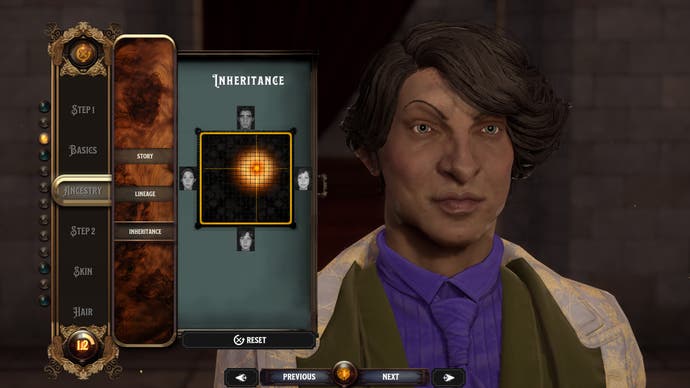
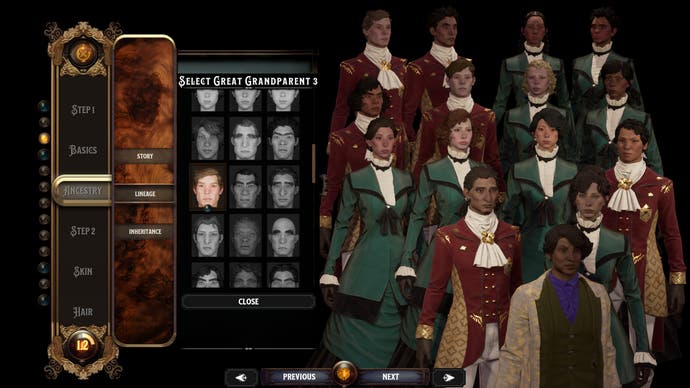
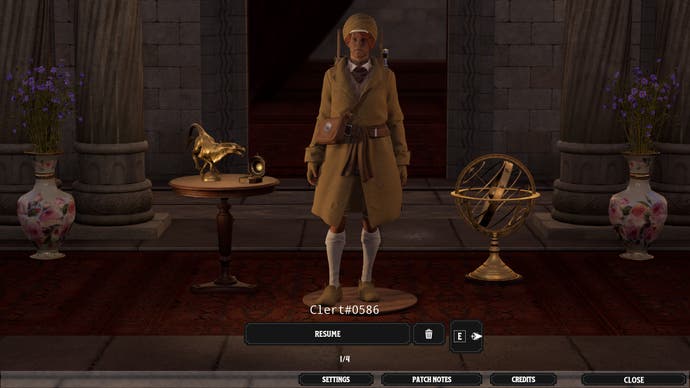
It doesn’t help that the things you’ll be doing over and over again aren’t very exciting. There’s a nice animation for chopping trees, whereby chunks fly off and the tree eventually topples, but you’ll do it so much it’ll make you numb with boredom – especially since better equipment requires more of it (turned into Lumber first, then carved, each step reducing the initial gather). It’s a similar thing for mining rock and ore. These things make up an inordinate amount of your playtime in the game, as does running back and forth to deposit them and work out what to craft with them. It’s donkey work.
Combat should be the reward, the excitement you’ve been grinding for, but it’s dreary early on. There’s a type of evil faction in the game that populates dungeons, in addition to the wildlife you find while adventuring, but they’re so overused and so lacking in group composition that any fear of them will be long exhausted by the time new types of them begin to appear. There are signs of a detailed combat system, in mechanics like blocking and enemy weak points, and shoving – and magic and guns later on – but there’s no apparent shape to fighting for dozens of hours. It’s just a mindless slog. I’m only now, 40 hours in, beginning to feel magic make its way into the game, and interesting spell types appear, which need to be attached to equipment to cast.
Exacerbating this sense of slog further is the time it takes to do anything in the game. Realm-hopping is one of the game’s central ideas, yet opening portals to other realms takes minutes at a time, then travelling through them takes minutes more, which might not sound like much written down, but is aggravating in practice, especially when you have to go back and forth. Distances, too, can be wearisome, especially when you have to travel across a map to reach an Essence Trader you need. There’s also a sense that because realms have been generated procedurally, things have often been placed without thought behind them, so they may be inexplicably at the top of a mountain, or in places it’s a trudge to get to. Mind you, once you get the climbing picks and umbrella, there is a base pleasure in climbing mountains and then leaping from them, though you probably won’t have enough stamina to do this effectively for a long time.
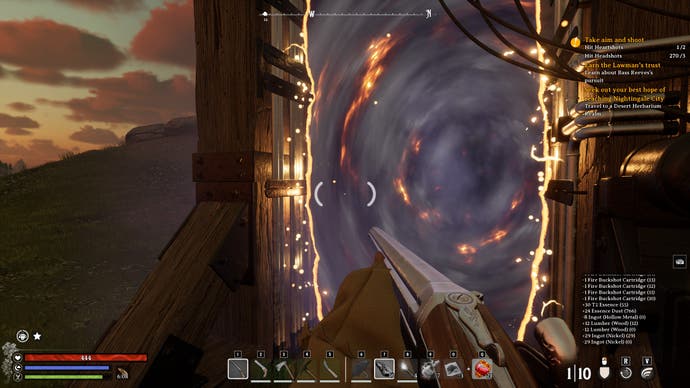
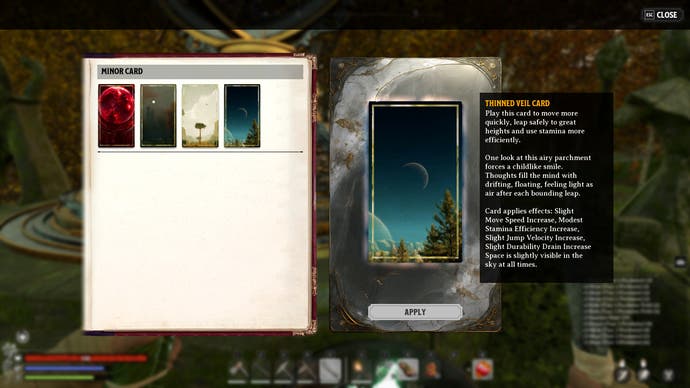

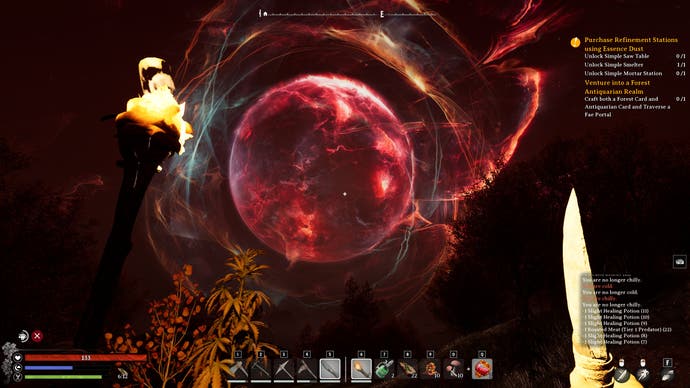
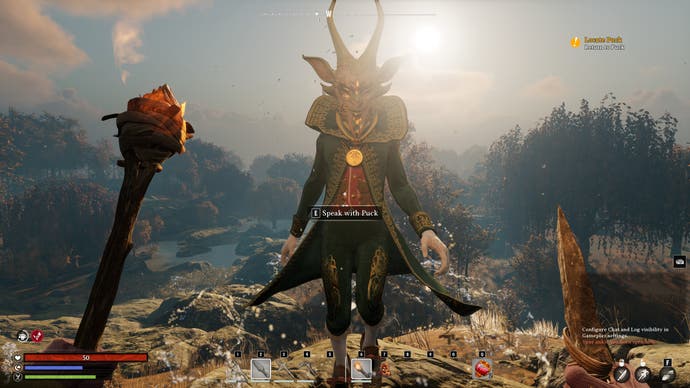
Time: that’s what drains away here, that’s what the game really takes. Its demands on you are much more like an MMO’s. My hope had been that Nightingale, a game led by former BioWare person Aaryn Flynn, would emphasise story and role-playing more than it would survival crafting, but that doesn’t seem to be true. There are elements of story, with a main quest and some side quests, but they amount to little more than fetch quests, and though some NPCs have reams of dialogue, none of it is voiced or animated, and the multiple choice answers you can choose between don’t seem to affect much.
I’ve been persevering with Nightingale because I’ve heard, and read, that when you reach tier 3, as people are calling it, the game opens up. You reach an endgame of sorts in a hub world called The Watch, where you find other players and go on raids together to fight the huge mythical creatures we’ve seen in the trailer. I’ve been pursuing it like it was some kind of Shambala. I believe I’m within touching distance of it now, on a quest to open a portal there, but as I turn one corner, another one appears, and several more sub-steps reveal themselves. I spent an hour fishing earlier just to get one kind of fish to grind into oil to turn into a lady as part of a quest step. Reaching The Watch could take hours more.
 Let’s Play Nightingale – CLERT ALERT!
Let’s Play Nightingale – CLERT ALERT!
But I have seen signs of life. I fought a huge Sun Giant, which felt new and exciting, though my current guns and equipment didn’t scratch it, and I’ve just now unlocked a new tier of upgrade for my equipment, which will help. But dealing with all that will take yet more time and more grinding, and more traipsing around, and I don’t know if I have the heart for it any longer. Nightingale has worn me down.
This is Early Access, though – early Early Access – and it’s worth underlining that fact. I imagine there’s still at least a year of open development to go, if not more, and that in that time, things will significantly change. Much needed variation will be added to the game, the story will be broadened, NPCs will be improved (the companion character I have won’t stop chopping down trees), combat tweaked and tuned, and there will be more things to do in the world, and more things to do them with. I hope so, anyway. More specifically, I hope pacing and progression are paid particular attention to, because they let down the whole experience as it is. It’s no good holding your treats back if no one ever gets to try them. People will simply turn away. There’s potential here, it just needs to be unlocked.
[ad_2]
Source link



